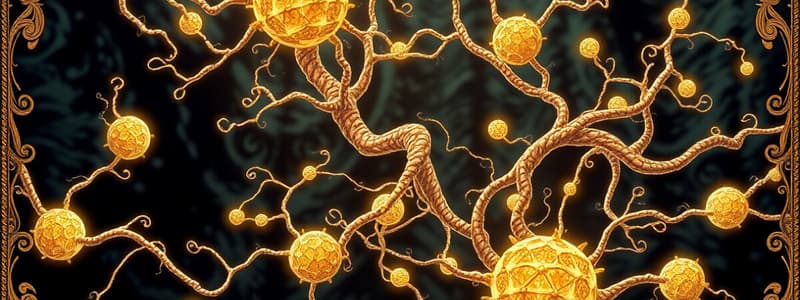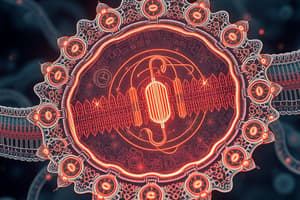Podcast
Questions and Answers
What percentage of modern medications are derived from plant sources?
What percentage of modern medications are derived from plant sources?
- 10%
- 75%
- 50%
- 25% (correct)
What ancient civilization referenced the use of opium patches for athletes?
What ancient civilization referenced the use of opium patches for athletes?
- Roman Empire
- Ancient Greece (correct)
- Ancient Egypt
- Mesopotamia
How many plant species have been documented for medical use worldwide?
How many plant species have been documented for medical use worldwide?
- 5,000
- 25,000
- 65,000
- 85,000 (correct)
Which plant is associated with protecting brain cells from toxins?
Which plant is associated with protecting brain cells from toxins?
When does archaeological evidence suggest the use of opium and magic mushrooms began?
When does archaeological evidence suggest the use of opium and magic mushrooms began?
What is the primary cannabinoid found in marijuana that is psychoactive?
What is the primary cannabinoid found in marijuana that is psychoactive?
Which cannabis species is typically associated with lower psychoactive effects due to its low THC content?
Which cannabis species is typically associated with lower psychoactive effects due to its low THC content?
What is the legal definition of hemp concerning THC content?
What is the legal definition of hemp concerning THC content?
What notable historical figure grew hemp on his plantation for about 30 years?
What notable historical figure grew hemp on his plantation for about 30 years?
How many distinct compounds are found in the leaves and flowering tops of cannabis plants?
How many distinct compounds are found in the leaves and flowering tops of cannabis plants?
What is the typical membrane potential of a neuron at rest?
What is the typical membrane potential of a neuron at rest?
Why is the inside of a neuron negatively charged relative to the outside?
Why is the inside of a neuron negatively charged relative to the outside?
What is the primary role of the sodium-potassium pump in neurons?
What is the primary role of the sodium-potassium pump in neurons?
Which ion experiences the strongest electrostatic pressure to move inside the neuron?
Which ion experiences the strongest electrostatic pressure to move inside the neuron?
What percentage of a neuron's energy sources is used by the sodium-potassium pump?
What percentage of a neuron's energy sources is used by the sodium-potassium pump?
What primarily attracts sodium ions (Na+) to move into the neuron?
What primarily attracts sodium ions (Na+) to move into the neuron?
Which ion has higher concentrations outside the neuron compared to inside?
Which ion has higher concentrations outside the neuron compared to inside?
Which ion is stuck inside the neuron and cannot freely move out?
Which ion is stuck inside the neuron and cannot freely move out?
What is the primary reason for the outside of the neuron being positively charged relative to the inside?
What is the primary reason for the outside of the neuron being positively charged relative to the inside?
What does diffusion refer to concerning ion movement in neurons?
What does diffusion refer to concerning ion movement in neurons?
What medical condition was William O'Shaughnessy interested in treating with cannabis?
What medical condition was William O'Shaughnessy interested in treating with cannabis?
Which individual is known as the 'father of modern medicine' and advocated for cannabis use?
Which individual is known as the 'father of modern medicine' and advocated for cannabis use?
What was a significant political factor that caused medicinal cannabis to fall out of favor in the United States?
What was a significant political factor that caused medicinal cannabis to fall out of favor in the United States?
What act imposed heavy taxes and fines on cannabis use in 1937?
What act imposed heavy taxes and fines on cannabis use in 1937?
Which organization opposed the Marihuana Tax Act of 1937?
Which organization opposed the Marihuana Tax Act of 1937?
In what decade was marijuana classified as a Schedule 1 substance?
In what decade was marijuana classified as a Schedule 1 substance?
What misconception does the Schedule 1 classification of cannabis perpetuate?
What misconception does the Schedule 1 classification of cannabis perpetuate?
Which cannabinoid has been approved by the FDA for medicinal purposes despite cannabis's Schedule 1 status?
Which cannabinoid has been approved by the FDA for medicinal purposes despite cannabis's Schedule 1 status?
What triggers depolarization and the action potential in a neuron?
What triggers depolarization and the action potential in a neuron?
What type of conduction occurs due to myelination of neurons?
What type of conduction occurs due to myelination of neurons?
Where does the action potential get retriggered in a myelinated neuron?
Where does the action potential get retriggered in a myelinated neuron?
What happens during decremental conduction in myelinated neurons?
What happens during decremental conduction in myelinated neurons?
What is a primary reason for the efficiency of myelinated neurons over unmyelinated ones?
What is a primary reason for the efficiency of myelinated neurons over unmyelinated ones?
Flashcards are hidden until you start studying
Study Notes
The Neuron at Rest
- Inside of a neuron, there is a negative charge relative to the outside (membrane potential).
- This is due to negatively charged proteins (A-) inside the neuron, low levels of Cl- and Na+ relative to the outside, and higher levels of K+ relative to the outside, but it does not overcome the negative charge from proteins.
- The outside of a neuron, on the other hand, is positively charged relative to the inside due to the presence of Na+ ions.
- The outside has higher levels of Cl- ions relative to the inside and low levels of K+ ions relative to the inside.
- The Sodium-Potassium pump is an active transporter that actively moves Na+ and K+ across the membrane. This keeps the balance of Na+ outside of the neuron by moving 3 Na+ ions outside for every 2 K+ ions brought inside. The pump is fueled by ATP, and consumes approximately 40% of the neuron’s energy.
- Diffusion drives ions to move from high concentrations to low concentrations.
- Electrostatic pressure, the pressure of opposite charges attracting, also affects ion movement. This pressure drives ions to move towards opposite charges and repel from similar charges.
The Forces that Surround a Neuron
- Na+ has a double force (both diffusion and electrostatic) moving it from outside to inside.
- Cl- ions diffuse into the cell because there is a higher concentration of them outside of the cell, but are repelled by A- ions inside.
The Action Potential: A domino effect
- When a neuron reaches a threshold of -55 mV (or -50), it triggers an “all-or-none” law that initiates depolarization and the action potential.
- Depolarization only occurs in localized sections of the neuron.
- In that localized section, voltage-dependent Na+ channels open.
- The signal may decrease by the time it reaches the next section (decremental conduction), but as long as it stays above -55 mV the process repeats (all-or-none depolarization; action potential).
Propagation of the Action Potential
- Most neurons are covered by a myelin sheath, which is produced by oligodendrocytes (CNS) or Schwann cells (PNS) and protects the neuron.
- The only place where ions can be exchanged is at the “Nodes of Ranvier”.
- Action potentials “jump” between nodes to propagate, which is called Saltatory Conduction.
- The action potential is retriggered at each Node of Ranvier and is much faster than propagation in non-myelinated neurons.
- Unmyelinated neurons do not “jump propagate” between nodes, they are less efficient and slower, and are important in somatosensory neurons for “pain”.
Cannabis
- Cannabis has been in use for thousands of years.
- A 2,700-year-old grave in Western China was found to have 789 grams of cannabis.
- Carbon dating confirmed hemp back to 4000 BC.
- Cannabis has three primary species: Cannabis sativa, Cannabis indica, and Cannabis ruderalis.
- Cannabis is a member of the plant family Cannabaceae.
- The leaves and flowering tops of cannabis plants contain at least 489 distinct compounds among 18 different chemical classes.
- Hemp is defined as a cannabis plant that contains less than 0.3% THC. Marijuana is a cannabis plant with more than 0.3% THC.
- CBD can be derived from both hemp and marijuana plants.
Cannabis In Historical Perspective
- George Washington, the first President of the United States, grew hemp on his plantation. Records indicate that he was interested in its medical properties.
- In the early 19th century, Irish Physician William O’Shaughnessy travelled to India and brought back a large supply of cannabis to treat issues including rheumatism, tetanus, cholera, pain, muscle relaxant, migraine, and epilepsy.
- In 1915, Sir William Osler advocated for cannabis use in migraine. He even said, "Cannabis indica is probably the most satisfactory remedy.”
- Cannabis use fell out of favor in the 20th century.
Cannabis and Politics
- Medicinal marijuana was derailed by political factors in the United States.
- The Federal Bureau of Narcotics, in the 1930s, linked psychosis, mental deterioration, addiction, and violent crimes to marijuana use.
- It is believed that The Marihuana Tax Act of 1937 (opposed by the American Medical Association) was created to reduce the growing hemp industry by prominent businesses like the nylon industry, which was becoming increasingly popular.
- The Marihuana Tax Act imposed heavy taxes and fines on any use of cannabis.
- Despite the Act, the Journal of the American Medical Association still recommended oral preparations of cannabis for migraine.
- Cannabis became stigmatized in the 1960s due to the “psychedelic hippie counterculture”.
- In 1970, marijuana was classified as a Schedule 1 substance (same as heroin and lysergic acid diethylamide (LSD)).
- The Schedule 1 classification has made it difficult to research the benefits of cannabis.
- There’s a contradiction to the Schedule 1 status because the Department of Health and Human Services, in 2001, filed a patent for “cannabinoids as antioxidants and neuroprotectants”.
- In 2020, Illinois legalized marijuana.
- The Federal Drug Administration (FDA) has approved synthetic versions of the cannabinoid Δ9-THC for medicinal purposes.
Studying That Suits You
Use AI to generate personalized quizzes and flashcards to suit your learning preferences.




